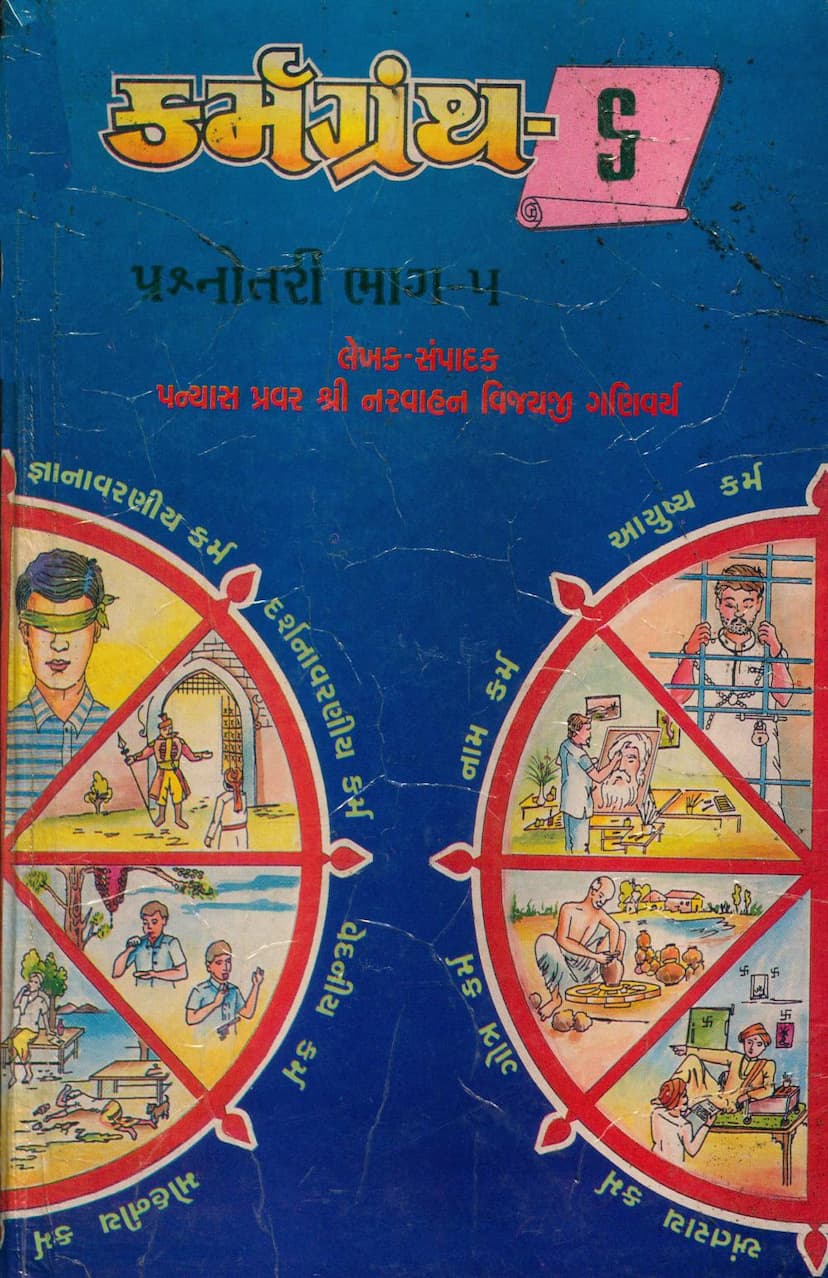Karmgranth 6 Prashnottari Part 05
Added to library: September 2, 2025

Summary
Here's a comprehensive summary of the Jain text "Karmgranth 6 Prashnottari Part 05" by Narvahanvijay, based on the provided text:
Book Title: Karmgranth 6 Prashnottari Part 05 Author: Panyasprver Shri Narvahanvijayji Ganivar Publisher: Padarth Darshan Trust, Ahmedabad
Overall Purpose: This book is the fifth part of a series on Karmic Grantha (texts dealing with karma) presented in a question-and-answer (Prashnottari) format. It delves into the intricate details of karmic bondage, manifestation (uday), and persistence (satta) for various types of souls across different stages of spiritual development (Jivasthanak).
Core Content: The book meticulously analyzes how the eight types of karmas in Jainism (Jnana-avaraniya, Darshana-avaraniya, Vedaniya, Mohaniya, Ayushya, Nama, Gotra, and Antaraya) behave in relation to the thirteen stages of soul development (Jivasthanak). It categorizes these stages by various classifications:
- By sense organs: Ekendriya (one-sensed), Bien-driya (two-sensed), Trin-driya (three-sensed), Chaurindriya (four-sensed), and Panch-endriya (five-sensed).
- By completeness of senses/development: Aparyapta (incomplete) and Paryapta (complete).
- By consciousness: Sanni (conscious) and Asanni (unconscious).
- By specific life forms: Further sub-classifications based on specific characteristics like microscopic (Sookshma) and macroscopic (Badar), and various stages of development within these categories.
Methodology: The core of the book lies in the detailed breakdown of "Samvedh Bhanga" (instances or configurations of manifestation) for each karma type across these soul categories. This involves:
- Bandh-sthan (Stages of Bondage): How many ways a particular karma can be bound.
- Uday-sthan (Stages of Manifestation): How many ways a karma can manifest its effects.
- Satta-sthan (Stages of Persistence): How many ways a karma remains in its latent state.
- Samvedh Bhanga (Instances of Manifestation): The specific combinations of bondage, manifestation, and persistence that occur at different soul stages.
Key Focus Areas (as indicated by the chapter/question numbering): The text progresses through a systematic examination, starting with:
- Chapters 1-8: Primarily focus on the behavior of Jnana-avaraniya and Antaraya karma in relation to the thirteen soul stages.
- Chapters 9-15: Shift to Darshana-avaraniya karma, analyzing its bondage, manifestation, and persistence across various soul types (from subtle one-sensed to conscious five-sensed).
- Chapters 16-26: Detail the nuances of Vedaniya, Ayushya, and Gotra karma across different soul categories, including the calculation of various "bhangan" (manifestation possibilities).
- Chapters 27-40: Dedicate extensive analysis to Mohaniya karma, exploring its complex stages of bondage, manifestation, and persistence across numerous soul classifications, often involving large numerical calculations.
- Chapters 41 onwards: Continue the detailed analysis for other karma types, such as Nama karma, examining the specific conditions and numerical possibilities of their manifestation across various soul types. The latter part of the book becomes extremely detailed, calculating numerous "samvedh bhanga" for different karma types across various classifications of life forms, including subtle one-sensed, macroscopic one-sensed, two-sensed, three-sensed, four-sensed, and various categories of five-sensed beings (conscious and unconscious, complete and incomplete).
Key Themes and Concepts:
- Granularity: The book emphasizes an extremely detailed and systematic approach to understanding karma, down to specific "bhangan" or instances for each karma type in relation to every possible soul state.
- Mathematical Precision: The text relies heavily on precise calculations to enumerate the various permutations and combinations of karmic bondage and manifestation.
- Jivasthanak Framework: The thirteen Jivasthanak provide the fundamental structure for analyzing the behavior of different karmas.
- Comprehensive Coverage: The Prashnottari format suggests an effort to cover a wide range of specific questions and scenarios related to karmic theory.
Publication Details:
- The publication is sponsored by Shri Lalbagh Motishah Jain Charities, Shri Gyankhata.
- The text is credited to Pujya Panyasprvar Shri Narvahan Vijayji Maharaj Saheb, a disciple of Acharyadev Shri Vimal Chandrasurishwarji Maharaj.
- The book is part of the "Prashnottari Granthamala Prakashan No. 22."
In essence, "Karmgranth 6 Prashnottari Part 05" is a highly technical and detailed Jain text that aims to provide an exhaustive analysis of the complex workings of karma according to Jain philosophy, presented in a systematic question-and-answer format. It is a deep dive into the permutations of karmic influence on different life forms across their spiritual journeys.